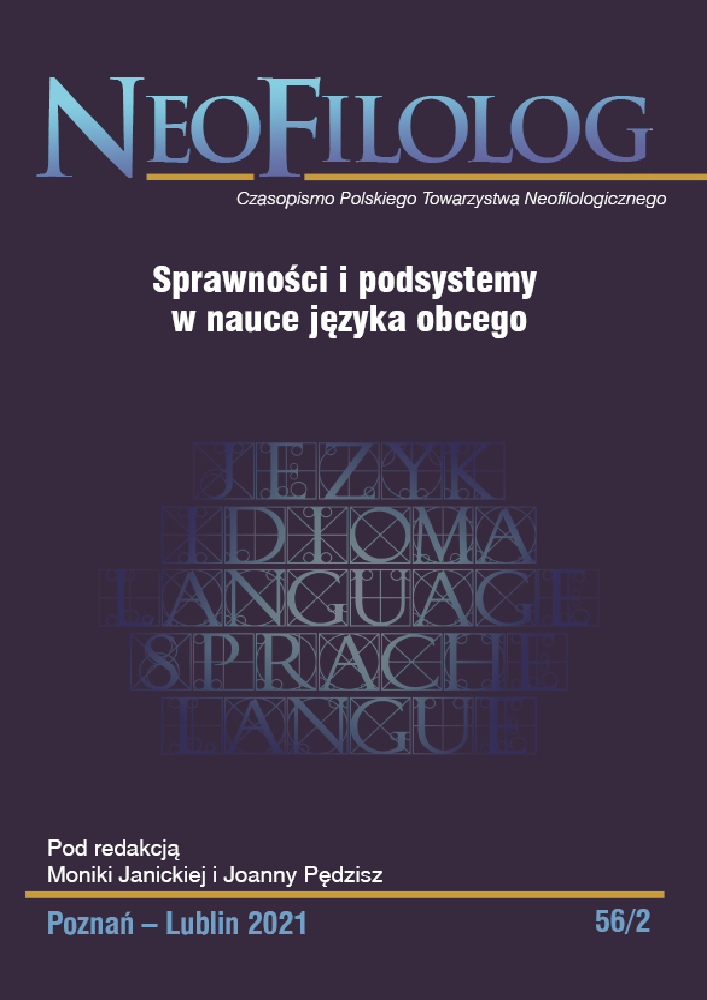Abstract
The paper emphasizes the role of linguistic intuition in current L2 processing. Intuition, as a mental disposition operating in implicit systems, is in close correlation with working memory. It infers quick, almost immediate meaning of un unknown word which appears in a context. Linguistic intuition has a regulatory function, i.e. it allows to continue language activities and overcome linguistic deficits. In the second part, Timed inference test as a tool for developing and testing vocabulary is proposed as well as the results of the empirical study on intuitive behaviour in L2. The results of the study show that inference of word’s meaning under time constraint is lower that the results of inference without time pressure. The study involves a group of 102 students of French as a foreign language at B1 level.
References
Baddeley A. (1998), Pamięć. Poradnik użytkownika. Warszawa: Prószyński i S-ka.
Baddeley A. (2007), Working memory, thought and action. Oxford: Oxford University Press.
Baddeley A. (2012), Working memory: Theories, Models, and Controversis. „Annual Review of Psychology”, nr 63, s. 1–29.
Cichoń M. (2011). Zdolny uczeń - autonomiczny uczeń: jak rozwijać skutecznie strategie uczenia się na lekcji języka obcego. „Neofilolog”, nr 36, s. 319–329.
Chomsky N. (1965). Aspects of the Theory of Syntax. Cambridge Massachu-setts: MIT Press.
Dakowska M. (2007), Psycholingwistyczne podstawy dydaktyki języków ob-cych. Warszawa: Wydawnictwo Naukowe PWN.
Desclés, J.-P. (1993). Relations casuelles et schèmes sémantico-cognitifs. „Langages”, 113, s. 113 – 125.
Dźwirzyńska E. (2016), Psychologiczne czynniki warunkujące możliwość intensyfikacji przyswajania obcojęzycznej leksyki w procesie kształtowania kompetencji komunikacyjnej. „Linguodidactica”, Tom XX, s. 51–61.
Gao, H. (2012), A quantitative study into Chinese EFL learners’ lexical infer-ence ability and strategy use in EFL reading. „Linguistic Culture Education”, 1, s. 58–77.
Gigerenzer G. (2007), Le génie de l’intuition. Intelligence et pouvoirs de l’inconscient. Przeł. M. Garène, Paris: Belfond.
Jung C.G. (1921/2015), Typy psychologiczne. Przeł. R. Reszke, Warszawa: Wydawnictwo KR.
Komorowska H. (2002), Metodyka nauczania języków obcych. Warszawa: Fraszka Edukacyjna.
Kwapisz-Osadnik K. (2010), Językoznawstwo kognitywne w nauczaniu języ-ków obcych: projekt gramatyki wizualnej na przykładzie francuskiego trybu subjonctif. „Neofilolog”, nr 34, s. 133–147.
Laskowski M. (2009), Związki frazeologiczne jako problem dydaktyczny na lekcjach języków obcych. „Języki obce w szkole”, 2, s. 16–28.
Lewandowska-Tomaszczyk B.(2006), Metody empiryczne i korpusowe w językoznawstwie kognitywnym, (w:) Stelmaszczyk P. (red.), Metodologia językoznawstwa. Podstawy teoretyczne. Łódź: Wydawnictwo Uniwersytetu Łódzkiego, s. 251–281.
Nation I. S. P. (2001), Learning vocabulary in another language, Cambridge: Cambridge University Press.
Nosal C. S. (2010), Umysł poczwórnie ograniczony. Bariery i kompensacje w poznaniu. „Studia z kognitywistyki i filozofii umysłu”, nr 4, s. 5–25
Nosal C. S. (2011), Interakcja inteligencji i intuicji: nowa teoria funkcjonowa-nia umysłu. „Czasopismo Psychologiczne”, Tom 17 nr 2, s. 207–218.
Pawlak M. (2010), Problemy pomiaru wiedzy językowej. „Neofilolog”, nr 35, s. 9–22.
Piegzik W. (2020), Intuicja językowa i jej funkcja oceniająca: na przykładzie języka francuskiego jako obcego. „Prace Językoznawcze”, XXII/1, s. 219–238.
Piegzik W. A. (w druku), Od intuicji językowej do zachowań intuicyjnych w języku: na przykładzie języka francuskiego jako obcego. Warszawa: Wydawnictwo Naukowe PWN.
Redouane, R. (2004), Assessing institutional method in L2 French vocabulary ac-quisition: Guessing-from-context method versus a word-list method. On line: http://homepage.mac.com/Tefftennant/welfa/WELFA [DW: 2.02.2021]
Roch E. (1978), Principles of categorization, (w:) Roch E. (red.) Cognition and Categorization. B.B. Lloyd, New Jersay: Hillsdale, s. 27–48.
Sułkowska M. (2018), Phraséologie appliquée et ses nouvelles branches : phraséodidactique et phraséotraduction. „Romanica Cracoviensia”, 3, s. 159–170.
License
Copyright (c) 2021 Wioletta A. Piegzik

This work is licensed under a Creative Commons Attribution-NoDerivatives 4.0 International License.
Authors
Authors of texts accepted for publication in Neofilolog are required to complete, sign and return to the Editorial team’s office the Agreement for granting a royalty-free license to works with a commitment to grant a CC sub-license.
Under the agreement, the authors of the texts published in Neofilolog grant Adam Mickiewicz University in Poznań a non-exclusive, royalty-free license and authorize the use of Attribution-NoDerivatives 4.0 International (CC BY-ND 4.0) Creative Commons sub-license.
The authors retain the right to the free disposal of the work.
Users
Interested Internet users are entitled to use works that have been published in Neofilolog since 2017, under the following conditions:
▪ attribution – obligation to provide, together with the distributed work, information about the authorship, title, source (link to the original work, DOI) and the license itself.
▪ no derivatives – the work must be preserved in its original form. Without the author's consent, it is not possible to distribute the modified work in the form of translations, publications, etc.
Copyrights are reserved for all texts published since 2017.
Miscellaneous
Adam Mickiewicz University in Poznań retains the property right as a whole (layout, graphic form, title, cover design, logo etc.).

